Etruscan Architecture › Etruscan Art › Old Testament Pseudepigrapha » Origins and History
Articles and Definitions › Contents
- Etruscan Architecture › Ancient History
- Etruscan Art › Ancient History
- Old Testament Pseudepigrapha › Antique Origins
Ancient civilizations › Historical places, and their characters
Etruscan Architecture › Ancient History
Definition and Origins
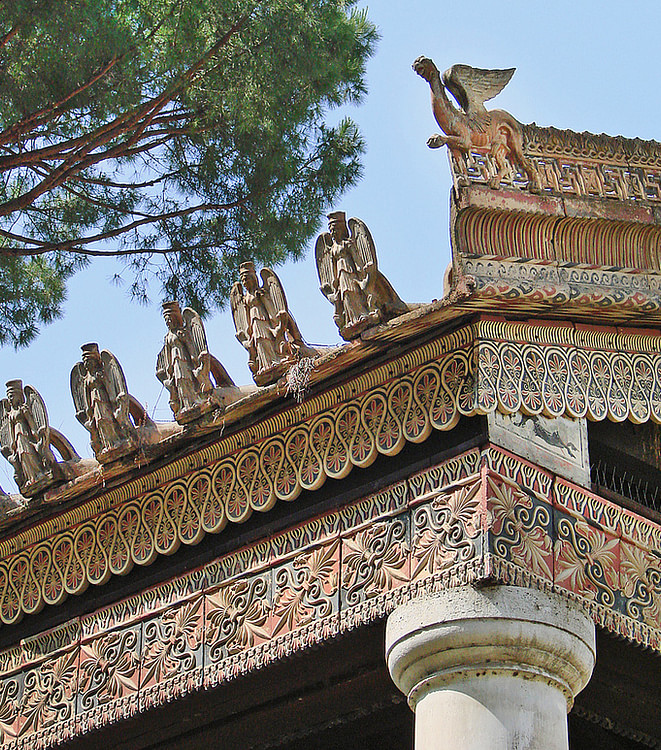
The architecture of the Etruscan civilization, which flourished in central Italy from the 8th to 3rd century BCE, has largely been obliterated both by the conquering Romans and time, but the very influence of the Etruscans on Roman architectureand the impression their buildings made on later writers give tantalising clues as to what we are missing. Pottery models, tomb paintings, and excavations at such sites as Tarquinia, Vulci, Veii, and Cerveteri have revealed tangible evidence that Etruscan architects were both innovative and ambitious. The Tuscan column, arched gate, private villa with atrium, and large-scale temples on impressive raised platforms with extravagant terracotta decorations are just some of the innovations that would be copied and adapted by their cultural successors in Italy.
PROBLEMS OF RECONSTRUCTION
Unfortunately, reconstructing the towns and buildings of the Etruscans is made difficult by the absence of any substantial remains. There is, alas, no Parthenon or Pompeii for this long and influential civilization. In addition, a great number of Etruscan towns were completely covered by later cities in the medieval and modern periods, making any excavations today either problematic or impossible. Other sources of information are required, and fortunately, the Etruscans themselves are able to provide it in their depictions of architecture in tomb paintings and pottery vessels made in the form of buildings from primitive huts to large temples. Roman writers, too, have contributed to our greater knowledge of Etruscan architecture through their admiring descriptions. Finally, one area where no texts or reconstructions are needed are the thousands of surviving tombs the Etruscans built, which evolved over the centuries from tumuli to grand stone-vaulted chambers housing multiple generations of the dead.
FROM THE MID-6TH CENTURY BCE, LARGER PRIVATE BUILDINGS HAD GABLED ROOFS SUPPORTED BY COLUMNS & AN ATRIUM, CREATING A COURTYARD OPEN TO THE SKIES.
ETRUSCAN HOUSING
Although Etruscan tombs were seemingly built to last for centuries using stone or rock-cut chambers, everyday domestic architecture was built from more perishable materials: wood, sun-dried mud brick, or waddle and daub for the walls. Examples of the 7th-6th-century BCE circular and oval huts at Acquarossa show that the walls there once had a plaster covering.Wooden poles provided additional support and held up a thatch roof. Stone was sometimes used for foundations and lower levels, though. As with larger public buildings, the roofs of houses may have been decorated with terracotta additions such as palmettes, lotus motifs, and figurines. Saddle tiles of the same material protected the apex of the roof of rectangular buildings, while examples of a centre tile with a hole in it survive from round structures, made to either admit light or allow smoke to escape. Such a tile from Acquarossa came with a disc cover to close the hole in case of rain. Beams were protected by nailing terracotta plaques to the exposed ends. Eventually, roof tiles would replace thatch.

Etruscan Model House
From the early 6th century BCE houses have multiple intercommunicating rooms, sometimes with a hall and a private courtyard. These still have only one floor. Excavations show that early communities had some basic form of planning with several houses arranged around a shared courtyard. This was also advantageous for the construction of rock-cut drainage channels placed between houses, which led off to cisterns, although, in some towns, the further from the centre, the more haphazard the placement of buildings.
From the mid-6th century BCE larger private buildings, probably influenced by the architecture of Asia Minor and Phoenicia, had gabled roofs supported by columns. They had an atrium, an entrance hall open to the sky in the centre and with a shallow basin on the floor in the middle for collecting rainwater. Opposite was a large room with a hearth and cistern and side rooms including accommodation for servants.

Etruscan Model House
Early Etruscan settlements were constructed on easily defended plateaus and ridges, but those towns located in places considered vulnerable to attack were further protected by stone walls and ditches. The settlement at Marzabotto is a good example of town planning with the 5th century BCE buildings oriented on a north-south axis and set in a grid pattern. We know that the Etruscans were particularly concerned with rituals and rites connected to planning and the layout of buildings and considered certain arrangements auspicious.
ETRUSCAN TEMPLES
The earliest Etruscan sacred spaces had no architecture to speak of, merely being an outdoor area defined as sacred with an altar where rites were performed. Some areas had a rectangular podium from where omens could be observed. Over time, buildings, probably only of wood and thatch, were erected within the sacred space, which had a variety of functions, including accommodation. The first Etruscan stone temple appears at Veii c. 600 BCE. That secondary buildings were also constructed in stone then is attested by the 6th-century BCE altar platform at Cortona. Measuring 5 x 6.5 metres and reaching a height of 2 metres, the altar is approached by a flight of 10 steps with balustrades. Such secondary buildings and the sacred area itself were often enclosed by a low rubble wall punctuated by occasional supports of cut blocks or even an entire outer facing of dressed stone.
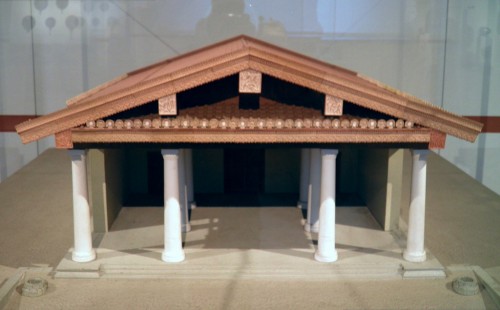
Etruscan Temple Model
Etruscan temple architecture has been difficult to reconstruct because of the lack of surviving examples. The Roman architect and writer Vitruvius describes a distinct 'Tuscan temple' with a columned portico and three small chambers at the rear interior, but evidence points to a more varied reality even if some basic features are common. Temples are almost square, unlike the obviously rectangular Greek temples, and placed on a much higher platform. Columns are known as the Tuscan type and, like the Doric order, they have no flutes but they do stand on a base. These support the roof which overhangs the entrance creating a deep porch.
One of the best-documented Etruscan temples is the c. 510 BCE Portonaccio Temple at Veii. It was built on an almost square base of volcanic tufa blocks measuring 18.5 m along the sides. With a front stepped-entrance, columned veranda, side entrance, and three-part cella, it does match Vitruvius' description. The roof was decorated with brightly painted life-size figure sculpture made in terracotta, a figure of a striding Apollo survives. Antefixes on the eves, again in terracotta, represented Maenads and Gorgons. The temple was perhaps dedicated to Menrva (the Etruscan version of Athena / Minerva ). Other sites with similar large temples include Pyrgi (Temples A and B) – one of the three ports of Cerveteri, Tarquinia (the Ara della Regina) and Vulci (the Great Temple). As in Greek temples, the actual altar and place of religious ceremonies remained outside the temple itself.
ETRUSCAN TOMBS
Simple stone cavities cut into the ground, with a jar of the deceased's ashes and a few daily objects placed in them, gave way to larger stone tombs enclosed in tumuli and, even later, free-standing buildings often set in orderly rows. These latter 7th-5th-century tumuli and block tombs had more impressive goods buried with the uncremated remains of the dead such as jewellery, dinner service sets, and even chariots.

Tomb of the Chariots, Populonia
Tumuli are made from a circular tufa block base and lower courses arranged in a circle. Alternatively, they are cut from existing rock at the chosen site. These low walls can have simple moulded decoration. A stone corridor leads to a central chamber, which is made to resemble a house with painted windows and door, or in the case of the earliest, with its low ceiling painted to imitate tent fabric and thus the even earlier Etruscan practice of burying the dead in tents. Some corridors and chambers have corbelled roofs such as the 7th-century BCE tomb at Volterra with its domed roof created by ever-decreasing rings of small stone blocks. Drainage was provided by either sloping stone slabs placed across the roof or building the whole tomb on a sloping stone base as seen in the Tomb of the Chariots at Populonia. The whole structure was then covered with a mound of earth. Some of the largest tumuli, such as at Cerveteri, measure up to 40 metres in diameter. Many of these tombs were in use over several generations.
A new type of tomb appeared from the 6th century BCE, the small free-standing block with gabled roof. These cube-like structures are best seen in the Banditaccia necropolis of Cerveteri. They are built using large stone blocks and, again, can incorporate natural rock at the site; each has a single doorway entrance and inside are stone benches on which the deceased were laid, carved altars, and sometimes stone seats. Set in rows, the tombs perhaps indicate a greater concern with town planning at that time.
Etruscan tombs from the Hellenistic period evolve into two new designs, best seen at Chiusi. One type is constructed from well-cut blocks and has a barrel vault much like Macedonian tombs. The second type has a much more impressive entrance tunnel; some are up to 25 metres in length. The interiors, conversely, are plainer with a simple rectangular or cross-shaped chamber lined with benches and niches on which were placed funerary jars and sarcophagi. These tombs were used over several generations, too, and in some cases, the entrance tunnels became the tomb itself with no end chamber built; one example has 39 niches for placing remains.
The walls of the tombs of the Etruscan elite were painted with colourful and lively scenes from mythology, religious practices, and Etruscan daily life, especially banquets and dancing. Architectural features are present framing such scenes or are even depicted in them. Tombs frequently have a painted door and frame, for example, as a metaphor for the deceased's passage into the next life. Other features appearing in paint include windows and columns and these are helpful in substantiating archaeological excavations of real buildings.
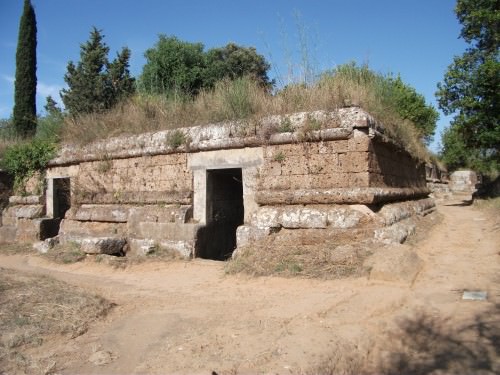
Etruscan Square Tomb, Cerveteri
LEGACY
The vaulted ceilings, arches, Tuscan column, and monumental city gates of Etruscan architecture would influence and inspire later Roman architects. Indeed, Etruscan builders were responsible for Rome 's most important early temple, that of the 6th-century BCE Jupiter Optimus Maximus on the Capitoline Hill. Etruscan arched gates would be, as with so many other areas of Roman design, made much grander and ostentatious, eventually morphing into the triumphal arch. The Etruscan use of tombs from the Hellenistic period to inter a large number of remains would influence the Romans in their later columbariawhere hundreds of remains would be neatly entombed on multiple levels. Finally, the atrium house design was adopted and adapted by the Romans, too, who gave it the name atrium tuscanicum in acknowledgement of their architectural debt to the Etruscans.
Etruscan Art › Ancient History
Definition and Origins
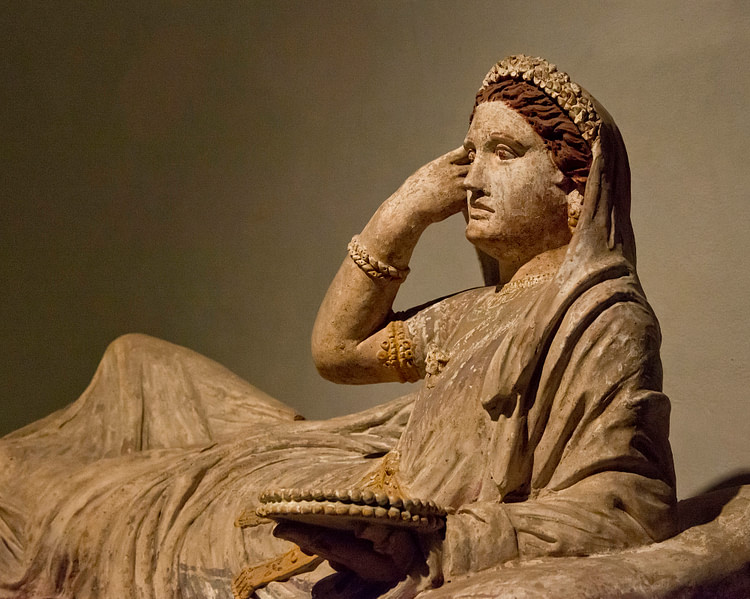
The art of the Etruscans, who flourished in central Italy between the 8th and 3rd century BCE, is renowned for its vitality and often vivid colouring. Wall paintings were especially vibrant and frequently capture scenes of Etruscans enjoying themselves at parties and banquets. Terracotta additions to buildings were another Etruscan speciality, as were carved bronze mirrors and fine figure sculpture in bronze and terracotta. Minor arts are perhaps best represented by intricate gold jewellery pieces and the distinctive black pottery known as bucchero whose shapes like the kantharos cup would inspire Greek potters.
INFLUENCES & DEVELOPMENTS
The identification of what exactly is Etruscan art - a difficult enough question for any culture - is made more complicated by the fact that Etruria was never a single unified state but was, rather, a collection of independent city -states who formed both alliances and rivalries with each other over time. These cities, although culturally very similar, nevertheless produced artworks according to their own particular tastes and whims. Another difficulty is presented by the consequences of the Etruscans not living in isolation from other Mediterranean cultures. Ideas and art objects from Greece, Phoenicia, and the East reached Etruria via the long-established trade networks of the ancient Mediterranean. Greek artists also settled in Etruria from the 7th century BCE onwards and many works of Etruscan art are signed by artists with Greek names. Geography played its part, too, with coastal cities like Cerveteri due to their greater access to sea trade, being much more cosmopolitan in population and artistic outlook than more inland cities like Chiusi.
THE ETRUSCANS GREATLY APPRECIATED FOREIGN ART & READILY ADOPTED IDEAS & FORMS PREVALENT IN OTHER CULTURES.
Greek art, and especially work from Athens, was highly esteemed then, as it still is now, but it is an error to imagine that Etruscan art was merely a poor copy of it. Etruscan and Greek artists in Etruria may have sometimes lacked the finer techniques of vase-painting and sculpture in stone that their contemporaries in Greece, Ionia, and Magna Graecia possessed but, at the same time, other art forms such as gem-cutting, goldwork, and terracotta sculpture show that the Etruscans had a greater technical knowledge in these areas. Whilst it is true that the Etruscans often tolerated works of a lower quality than would have been accepted in the Greek world, that does not mean they were not capable of producing art which was the equal of that produced elsewhere.
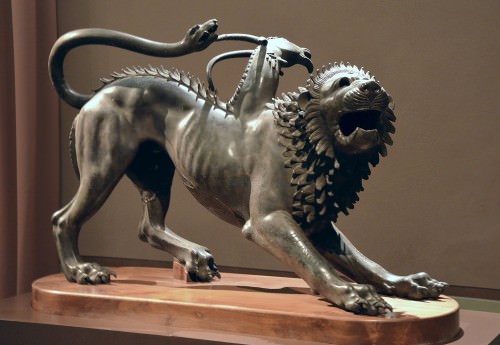
Chimera of Arezzo
The Etruscans, then, greatly appreciated foreign art (their tombs are full of imported pieces) and they readily adopted ideas and forms prevalent in the art of other cultures, but they also added their own twists to conventions. The Etruscans, for example, produced nude statues of female deities before the Greeks did, and they uniquely blended Eastern motifs and subjects (especially mythological ones and creatures never present in Etruria like lions) with those from the Greek world and their own homegrown ideas which can be traced back to the indigenous Villanovan culture (c. 1000 - c. 750 BCE), the precursor to the Etruscan culture proper. This perpetual synthesis of ideas is perhaps best seen in funerary sculpture.Terracotta coffin lids with a reclining couple in the round may, when one inspects each figure closely, resemble Archaic Greek models but the physical attitude of the couple when seen as a pair and the affection between them which the artist has captured are entirely Etruscan.
ETRUSCAN TOMB PAINTING
Perhaps the greatest legacy of the Etruscans is their beautifully painted tombs found in many sites like Tarquinia, Cerveteri, Chiusi, and Vulci. The paintings depict lively and colourful scenes from Etruscan mythology and daily life (especially banquets, hunting, and sports), heraldic figures, architectural features, and sometimes even the tomb's occupant themselves.Portions of the wall were often divided for specific types of decoration: a dado at the bottom, a large central space for scenes, a top cornice or entablature, and the triangular space, also reserved for painted scenes, reaching the ceiling like the pediment of a classical temple.
The colours used by Etruscan artists were made from paints of organic materials. There is very little use of shading until influence from Greek artists via Magna Graecia and their new chiaroscuro method with its strong contrasts of light and dark in the 4th century BCE. At Tarquinia, the paintings are applied to a thin base layer of plaster wash with the artists first drawing outlines using chalk or charcoal. In contrast, many of the wall paintings at Cerveteri and Veii were applied directly to the stone walls without a plaster underlayer. Only 2% of tombs were painted, and so they are a supreme example of conspicuous consumption by the Etruscan elite.
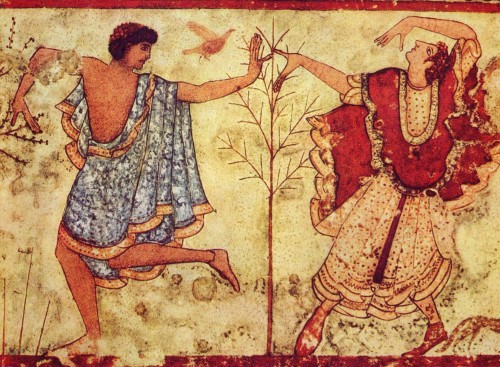
Dancers, Tomb of the Triclinium, Tarquinia
The late 4th-century BCE Francois Tomb at Vulci is an outstanding example of the art form and has a duel from Theban myth, a scene from the Iliad, and a battle scene between the city and local rivals, including some warriors with Roman names.Another fine example is the misleadingly named Tomb of the Lionesses at Tarquinia, built 530-520 BCE, which actually has two painted panthers, a large drinking party scene, and is interesting for its unusual checkered pattern ceiling. In the Tomb of the Monkey, also at Tarquinia, constructed 480-470 BCE, the ceiling has an interesting single painted coffer which has four sirens supporting a rosette with a four-leafed plant. The motif would reappear in later Roman and early Christian architecture but with angels instead of sirens.
ETRUSCAN SCULPTURE
Etruria was fortunate to have rich metal resources, especially copper, iron, lead, and silver. The early Etruscans put these to good use, and bronze was used to manufacture a wide range of goods but our concern here is sculpture. Bronze was hammered, cut, cast using moulds or the lost-wax technique, embossed, engraved, and riveted in a full range of techniques.Many Etruscan towns set up workshops specialising in the production of bronze works, and to give an idea of the scale of production, the Romans were said to have looted more than 2,000 bronze statues when they attacked Volsinii (modern Orvieto ) in 264 BCE, melting them down for coinage.
BRONZE FIGURINES, OFTEN WITH A SMALL STONE BASE, WERE A COMMON FORM OF VOTIVE OFFERING AT SANCTUARIES.
Bronze figurines, often with a small stone base, were a common form of votive offering at sanctuaries and other sacred sites.Some, as with those found at the Fonte Veneziana of Arretium, were originally covered in gold leaf. Most figurines are women in long chiton robes, naked males like the Greek kouroi, armed warriors, and naked youths. Sometimes gods were presented, especially Hercules. A common pose of votive figurines is to have one arm raised (perhaps in appeal) and holding an object - commonly a pomegranate, flowers, or a circular item of food (probably a cake or cheese). Fine examples of smaller bronze works include a 6th-century BCE figurine of a man making a votive offering from the 'Tomb of the Bronze Statuette of the Offering Bearer' at Populonia. Volterra was noted for its production of distinctive bronze figurines which are extremely tall and slim human figures with tiny heads. They are perhaps a relic of much earlier figures cut from sheet bronze or carved from wood and are curiously reminiscent of modern art sculpture.

Etruscan Bronze Youth
Celebrated larger works include the Chimera of Arezzo. This fire-breathing monster from Greek mythology dates to the 5th or 4th century BCE and was probably part of a composition of pieces along with the hero Bellerophon, who killed the monster, and his winged horse Pegasus. There is an inscription on one leg which reads tinscvil or 'gift to Tin', indicating that it was a votive offering to the god Tin (aka Tinia), head of the Etruscan pantheon. It is currently on display in the Archaeological Museum of Florence.
Other famous works include the Mars of Todi, a striking near life-size youth wearing a cuirass and who once held a lance. In the other hand he was probably pouring a libation. It is now in the Vatican Museums in Rome. The Minerva of Arezzo is actually a representation of Menerva, the Etruscan goddess, who was the equivalent of the Greek goddess Athena and Roman deity Minerva. Finally, the Portrait of a Bearded Man often known as 'Brutus' after the first consul of Rome (without any connecting evidence) is a striking figure. Most art historians agree that on stylistic grounds it is an Etruscan work of around 300 BCE. It is now on display in the Capitoline Museums of Rome.
ETRUSCAN BRONZE MIRRORS
The Etruscans were much criticised by their conquerors the Romans for being rather too effeminate and party-loving, and the high number of bronze mirrors found in their tombs and elsewhere only fuelled this reputation as the ancient Mediterranean's great narcissists. The mirrors, known to the Etruscans as malena or malstria, were first produced in quantity from the end of the 6th century BCE right through to the 2nd century BCE. Besides being an object of practical daily use, mirrors, with their finely carved backs, were a status symbol for aristocratic Etruscan women and were commonly given as part of a bride's dowry.
Designed to be held in the hand using a single handle, the reflective side of mirrors was made by highly polishing or silvering the surface. Some mirrors from the 4th century BCE onwards were protected by a concave cover attached by a single hinge.The inside of the lid was often polished to reflect extra light onto the face of the user while the outside carried cut-out reliefs filled with a lead backing. The flat reverse side of bronze mirrors, if not left plain (half the surviving examples are so), was an ideal canvas for engraved decoration, inscription, or even carved shallow relief. Some handles were painted or had carved relief scenes too.
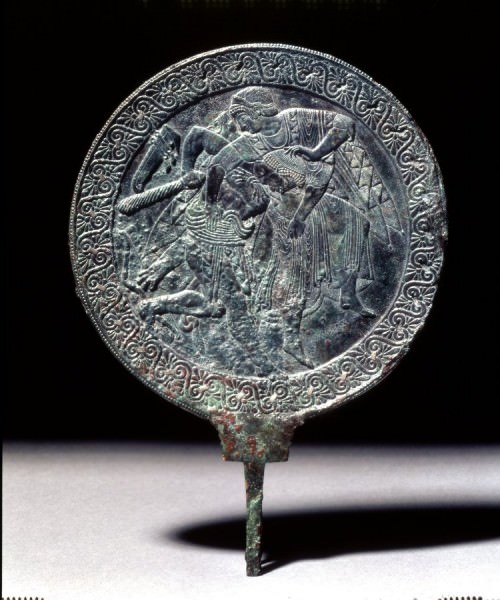
Etruscan Bronze Mirror Showing Hercules
The scenes and the people in them are often helpfully identified by accompanying inscriptions around the mirror edge. Popular subjects were wedding preparations, couples embracing, or a lady in the process of dressing. The most common subject for mirror decoration was mythology and scenes are often framed by a border of twisted ivy, vine, myrtle, or laurel leaves.
ETRUSCAN POTTERY
The first indigenous pottery of Etruria was the impasto pottery of the Villanovan culture. These relatively primitive wares contained many impurities in the clay and were fired only at a low temperature. By the end of the 8th century BCE, potters had managed to improve the quality. Small model houses and biconical urns (made of two vases with one smaller one acting as a lid for the other) were popular forms and used to store cremated human remains.
The next pottery type was red on white wares. This type of pottery, originating from Phoenicia, was produced in Etruria from the end of the 8th century BCE and into the 7th century BCE, particularly at Cerveteri and Veii. The red-coloured vessels were often covered with a white slip and then decorated with red geometric or floral designs. Alternatively, white was used to create designs on the unpainted red background. Large storage vases with small handled lids are common of this type and then kraters which also have scenes such as sea battles and marching warriors.
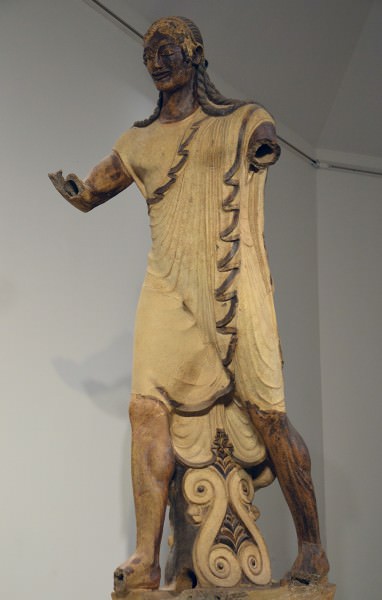
Apollo of Veii
Largely replacing impasto wares from the 7th century BCE, bucchero was used for everyday purposes and as funerary and votive objects. Turned on the wheel, this new type of pottery had a more even firing and a distinctive glossy dark grey to black finish. Vessels were of all types and most often plain but they could be decorated with simple lines, spirals, and dotted fans incised onto the surface. Three-dimensional figures of humans and animals could also be added. The Etruscans were Mediterranean-wide traders, too, and bucchero was thus exported beyond Italy to places as far afield as Iberia, the Levant, and the Black Sea area. By the early 5th century BCE, bucchero was replaced by finer Etruscan pottery such as black- and red-figure wares influenced by imported Greek pottery of the period.
ONE UNUSUAL FIELD OF POTTERY WHICH BECAME A PARTICULAR ETRUSCAN SPECIALITY WAS THE CREATION OF TERRACOTTA ROOF DECORATIONS.
One unusual field of pottery which became a particular Etruscan speciality was the creation of terracotta roof decorations. The idea went back to the Villanovan culture but the Etruscans went one step further and produced life-size figure sculpture to decorate the roofs of their temples. The most impressive survivor from this field is the striding figure of Apollo from the c. 510 BCE Portonaccio Temple at Veii. Private buildings also had terracotta decoration in the form of plants, palms, and figurines, and terracotta plaques with scenes from mythology were often attached to outer walls of all types of buildings.
The Etruscans buried the cremated remains of the dead in funerary urns or decorated sarcophagi made of terracotta. Both types could feature a sculpted figure of the deceased on the lid and, in the case of sarcophagi, sometimes a couple. The most famous example of this latter type is the Sarcophagus of the Married Couple from Cerveteri, now in the Villa Giulia in Rome. In the Hellenistic Period the funerary arts really took off, and figures, although rendered in similar poses to the 6th-century BCE sarcophagi versions, become less idealised and more realistic portrayals of the dead. They usually portray only one individual and were originally painted in bright colours. The Sarcophagus of Seianti Thanunia Tlesnasa from Chiusi is an excellent example.

The Arringatore (Orator)
LEGACY
The Etruscans were great collectors of foreign art but their own works were widely exported too. Bucchero wares, as we have seen, have been found across the Mediterranean from Spain to Syria. The Etruscans also traded with central and northern European tribes, and their artworks, thus, reached Celtic sites across the Alps in modern Switzerland and Germany. The greatest influence of Etruscan art, though, was on their immediate neighbours and cultural successors in general, the Romans.Rome conquered the Etruscan cities in the 3rd century BCE, but they remained independent centres of art production. Art works did reflect Roman tastes and culture, though, so that Etruscan and Roman art often became indistinguishable. An excellent example of the proximity between the two is the bronze statue of an orator from Pila, near modern Perugia. Cast in 90 BCE, the figure, with his toga and raised right arm, is as quintessentially Roman as a statue from the imperial period.
Aside from their obvious role in acting as a cultural link between the Greek world and ancient Rome, perhaps the most lasting legacy of Etruscan artists is the realism they sometimes tried to achieve in portraiture. Although still partially idealised, the funerary portraits on Etruscan sarcophagi are honest enough to reveal the physical flaws of the individual, and there is a clear attempt by artists to illustrate the unique personality of the individual. This was a concept that their Roman successors would also strive for and capture in very often moving portraits of private Roman citizens brilliantly rendered in paint, metal, and stone.
Old Testament Pseudepigrapha › Antique Origins
Ancient Civilizations
The Old Testament Pseudepigrapha are the non-canonical writings of Judaism and Christianity ranging from the 5th century BCE to the 9th century CE. Pseudepigrapha comes from a Greek noun denoting writings with a false superscription or name;however, in modern dialogue surrounding early Christianity and Judaism, it has come to denote non-canonical writings (ie Testament of Job, 1 Enoch, Letter of Aristeas) according to the Protestant biblical canon. The Pseudepigrapha are essential to understanding the historical developments and foundations of Judaism and Christianity as they relate to their historical context and demonstrate the various strands of traditions and types of communities.
DEFINITION & FRAMEWORK
What actually constitutes the Old Testament Pseudepigrapha is often contested; however, James Charlesworth provides five basic guidelines in his monumental edited volumes entitled The Old Testament Pseudepigrapha:
The following collection of fifty-two writings together… has evolved from the consensus that the Pseudepigrapha must be defined broadly so as to include all documents that conceivably belong to the Old Testament Pseudepigrapha... Those writings 1) that… are Jewish or Christian; 2) that are often attributed to ideal figures in Israel ’s past; 3) that customarily claim to contain God's word or message; 4) that frequently build upon ideas and narratives present in the Old Testament; 5) and that almost always were composed either during the period 200 BCE to 200 CE or, though late, apparently preserve, albeit in an edited form, Jewish traditions that date to that period. (Charlesworth, xxv)
As Charlesworth demonstrates, there is a certain ambiguity and uncertainty that comes with utilizing the term “pseudepigrapha”. At the end of the day, though, it must be recognized that this term is primarily meant to indicate a specific group of writings defined by a relatively loose framework. Because there is such variety in the Pseudepigrapha, note that it also operates to describe a collection of texts compiled in his 1983 volumes. In recent scholarly discussion, there is still argumentation about what should and should not be considered Pseudepigrapha, and even if it is a good term to categorize the literature.
AUTHORSHIP
WE DO NOT KNOW WHO ACTUALLY WROTE THE TEXT OF EACH PSEUDEPIGRAPHA; WHAT WE CAN DETERMINE IS WHERE IT WAS WRITTEN AND THE WORLDVIEW OF THE SCRIBE.
As mentioned previously, Pseudepigrapha as a Greek term means a false author; however, unlike the modern day in which the author and copyright information is an important part of a book, in antiquity the works were more malleable and open to adjustments, and the authors were less important. So, 2 Baruch, for example, claims to have been written by Jeremiah's disciple named Baruch, a historical figure from the 6th century BCE associated with the writing of the prophetic book in the Hebrew Bible called Jeremiah. Because internal evidence indicates a later date of composition (2nd century CE), we know that it was not written by Baruch. Even so, people did not have problems with attributing the text to an ancient figure, as it provided the text with ancient authority and intrinsic value.
In each Pseudepigrapha, then, we do not know who actually wrote the text. What we can determine oftentimes is where it was written and the worldview of the scribe who wrote the text. Understanding the scribe's view is important because it provides excellent insight into the historical situation and developments in early Judaism and Christianity.
HISTORICAL VALUE
The Pseudepigrapha provide a snapshot of a multitude of communities from within early Christianity and Judaism. Ultimately they allow us to see how the various historical situations and socio-religious reactions to conflict. This is reflected in descriptions of other people, theological statements, and appropriations of characters and stories from the Hebrew Bible, also known as the Old Testament.
For example, between the 2nd century BCE and 7th century CE, Jewish and Christian communities composed their own versions of Sibylline Oracles, a well-known literary genre in the ancient world. Heracleides Ponticus (c. 360-325 BCE), a Greek philosopher, considers the original Sibyl to have lived thousands of years before his time; yet, her voice and prophecy were still present. Likewise, Jewish tradition considers the Sybil to be the daughter of Noah. The similarities between how these two traditions interact demonstrate how early Jewish scribes sometimes transferred non-biblical roles to biblical characters.Consequently, we recognize that early Jewish scribes were connected to the world and traditions surrounding them in the midst of Hellenization.
Additionally, within the compiled Sibylline Oracles, we have insight into the developing worldviews of the community the scribes represent. In an appeal to eschatological completion, or things being perfected at the end of times, Sibylline Oracle 3:619-623 discusses what will happen to the world at the end of time:
And then God will give great joy to men,For earth and trees and countless flocks of sheepWill give to men the true fruitOf wine, sweet honey and white milkAnd corn, which is best of all for mortals.(Translation by JJ Collins)
Notable is that the Sibyl applies the imagery of a land flowing with milk and honey to the entire world despite it being originally used exclusively to the Israelites' “promised land” in the book of Exodus. Based on the internal evidence and its corroboration with external historical evidence, this passage may have been composed between 163 BCE and 145 BCE. In a later Sibylline Oracle, we see a completely different picture illustrated by the scribe:
But the holy land of the pious alone will bear all these things:A honey-sweet stream from rock and spring,And heavenly milk will flow for all the righteous.For with great piety and faith they put their hopIn the one begetter, God, who alone is eminent.(Translation by JJ Collins; 5:280-285)
In stark contrast to the previous one, this oracle is significantly more exclusive and applies the imagery of a land flowing with milk and honey exclusively to the land of the pious, or the land of Israel. While both texts agree on many theological ideas, the latter text was written in a period of socio-religious and political turmoil around the period of the destruction of the Second Temple (c. 70 CE) and the Bar Kokhba Revolt (c. 135 CE). These two events mark significant shifts in Jewish and Christian identities. By comparing how these writing, the former from a Jewish community in the 2nd century BCE and the latter from a Jewish community in the 2nd century CE, we see the development of how people actually responded to their historical conflicts and situations. Consequently, this trajectory allows us to better interpret and understand early Jewish and Christian history within their historical context.
OTHER PSEUDEPIGRAPHA
There are, of course, many texts considered Pseudepigrapha. The following will highlight select texts and briefly explain ways in which they are valuable to interpreting and understanding ancient history.
1 Enoch (2nd century BCE – 1st century CE) - This text is attributed to Enoch, the seventh generation after Adam and Eve according to biblical tradition. Based on the verse in which God takes Enoch from the earth (Gen. 5:24), 1 Enoch is a composite book about God revealing to Enoch the secrets of the universe, the course of history, and the future. The oldest layers of the book reflect upon the events surrounding the Maccabean Revolt. Also apparent is its influence from other books, demonstrating the development of Judean socio-religious ideology. It influenced 2 Enoch and 3 Enoch, the former written in the 1st century CE and the latter c. 5th century CE.
Sibylline Oracles (2nd century BCE – 7th century CE) - A compilation of several oracles, the Sibylline Oracles within Judeo-Christian tradition are attributed to the daughter of Noah. Following Alexander the Great ’s establishment of his empire, Judean culture, literature, and religious practice was influenced by Hellenistic culture. The Sibylline Oracles are reflective of how Judeans appropriated non-native literary and prophetic genres for their own intentions. Additionally, throughout the Oracles, we see how the scribes interacted with their historical situations through this literary medium.
Jubilees (161 – 140 BCE) – Based on biblical tradition, especially the books of Genesis and Exodus, Jubilees is a reworked account of what was purportedly revealed to Moses at Mount Sinai. Because it can be dated to approximately 150 BCE, it is valuable in that it reveals the reactions of a group of Jews to the Antiochus IV, who, according to 1 Maccabees, was intolerant of Jewish practices like circumcision, heavily encouraged nudity, and showed severe disrespect to their deity Yahweh, things severely against the sensibilities of Judeans of the time. Consequently, it is also a witness to the foundational ideology of the later Jewish sects, especially the Essene sect who focused greatly on purity.
Treatise of Shem (1st century BCE) – Drawing on the zodiac, this text applies the zodiac to Jewish thought and, beginning with the sign of Aries, writes for the sign of each year. It demonstrates that at the turn of the millennium Jews were, in fact, involved with astrology. Use of the zodiac by Jews at the turn of the millennium provides greater historical background for its presence in Rabbinic Jewish documents and an ancient synagogue from the 6th century CE (Beth Alpha). Additionally, it shows how ancient Jewish scribes developed their worldviews through alternative mediums, in this case the zodiac.
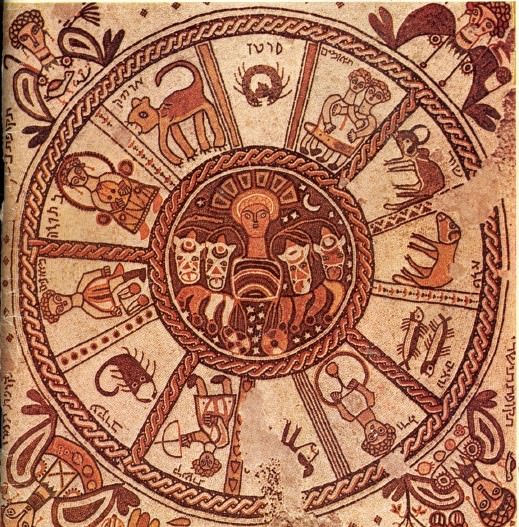
Zodiac Wheel Mosaic
Testament of the Twelve Patriarchs (2nd century BCE) – In the Hebrew Bible, Jacob has twelve sons, each of whom is considered the leader of a tribe of Israel in later traditions. Aside from various Christian additions to the text at a later period, each patriarch in the text has his own section in which he is “reflecting on aspects of his life, confessing his misdeeds, exhorting his family to avoid his sins and exemplify virtue, concluding with predictions about the future of Israel and giving instructions concerning his burial ” (HC Kee , 776). Most importantly, this text demonstrates the diversity in Judaisms prior to the Maccabean Revolt and, like other Pseudepigrapha, illustrates how certain Hellenistic ideas were appropriated for Jewish identities and worldviews.
CONCLUSION
These texts are not exhaustive by any means, nor are they representative of the diversity of Pseudepigrapha. Rather, these few selected Pseudepigrapha are meant to illustrate why the literature, commonly known as the Old Testament Pseudepigrapha, is important to understanding the historical foundation of Judaism and Christianity and diversity therein. For scholars, these texts assist in interpreting how the New Testament and Rabbinic Judaism emerged anew from the ruins of the Jerusalem temple in 70 CE. Likewise, they demonstrate and vividly illustrate the diversity in early Judaism and how it connected with its surrounding world and cultures.
LICENSE:
Article based on information obtained from these sources:with permission from the Website Ancient History Encyclopedia
Content is available under License Creative Commons: Attribution-NonCommercial-ShareAlike 3.0 Unported. CC-BY-NC-SA License